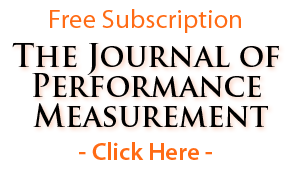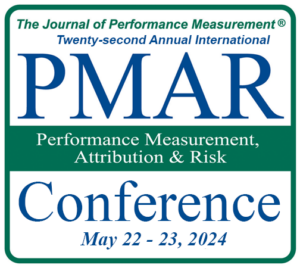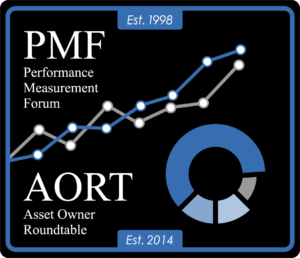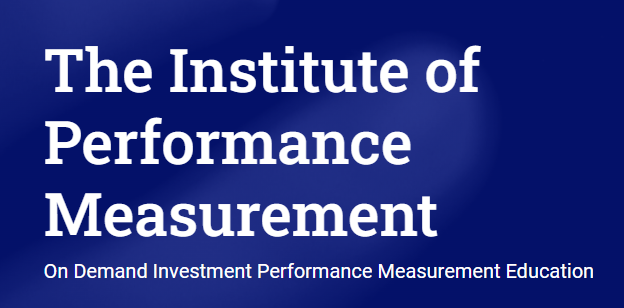Issue Contents
Asset-Weighted Standard Deviation:
A Cautionary Tale
When a composite has six or more members for the entire year, the Global Investment Performance Standards (GIPS®) requires compliant firms to report a measure of its internal dispersion, which the Standards define as a measure of the spread of the annual returns of portfolios. While the Standards do not require a specific measure to calculate internal dispersion, somewhere along the way, asset-weighted standard deviation became a popular way to do so. This was an idea that some folks thought made sense almost 30 years ago (since returns are asset-weighted, shouldn’t standard deviation?), but in reality, it didn’t then nor does it today. The problem: what does the number mean or represent? And, more importantly, does it provide value to a prospective client in interpreting performance?
We know that with equal-weighted standard deviation, the average return plus/minus one standard deviation, captures roughly two thirds of the total distribution of returns, however, the asset-weighted standard deviation does not have such a way to interpret it or to draw meaning from it.
It’s important to note (when calculating standard deviation) that whether you’re using asset-weighting or equal-weighting, it’s against the returns of all account’s present for the full year. You’re measuring standard deviation against the average of these returns, which in almost all cases will not be the same as the composite’s return, meaning it tells us how disparate the returns are around this average, not the average reported in the composite’s GIPS report (which, of course, is an asset-weighted average).
The asset-weighted version of standard deviation can introduce complexities and misinterpretations that should be considered. Asset-weighted standard deviation is influenced disproportionately by larger-sized portfolios as its average is asset-weighted. This means that a large portfolio can overshadow the risk contribution of smaller, but potentially more volatile, portfolios. As a result, it may not accurately reflect the overall risk of the strategy, as measured by variability. For non-model strategies, asset-weighted standard deviation may overemphasize decisions made based on portfolio size, e.g., if a strategy uses individual bonds in large sized portfolios and an ETF substitute in smaller-sized portfolios in the same composite.
Rather than relying on asset-weighted standard deviation, an alternative approach to better assess a strategy’s risk is a tail risk measure, which the Standards refer to as the high-low and range. Tail risk metrics focus on the extreme outcomes or “tail events” in a portfolio’s distribution of returns. These metrics are particularly useful for assessing the risk of severe losses. Their disadvantage is that they showcase the outliers, which may not provide as much value as equal-weighted standard deviation. It is rare for us to find their use among our verification clients.
An important point: while the AIMR-PPS® recommended asset-weighted standard deviation, the GIPS standards do not, perhaps because the decision makers recognize its shortcomings, the biggest perhaps being that there is no way to interpret it.
Asset-weighted standard deviation, while a frequently used metric for reporting internal dispersion in GIPS reports, has limitations that investors should be aware of. When we get verification clients who use this metric, we always recommend they change to the equal-weighted form.
Have an opinion? Please share it with Patrick Fowler.
GIPS® is a registered trademark owned by CFA Institute. CFA Institute does not endorse or promote this organization, nor does it warrant the accuracy or quality of the content contained herein.
Quote of the Month
“The trouble with the world is not that people know too little, but that they know so many things that aren’t so.”
– Mark Twain
GIPS® Tips
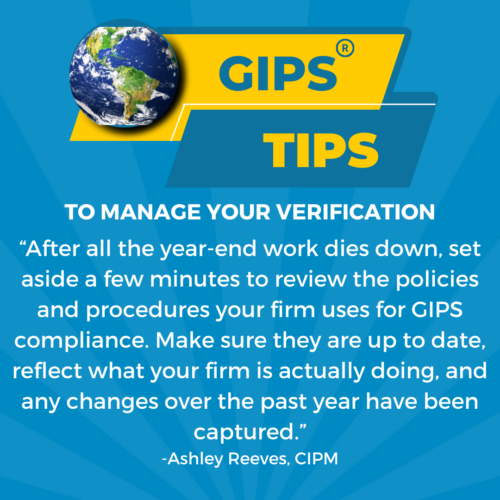
The Journal of Performance Measurement®
Check out this great article, “Data Quality Working Group – Report of Findings” by Claude Giguère of Robust Technologies, appearing in Volume 28, Issue #1 (Fall 2023) of The Journal of Performance Measurement. You can access this article, along with the other articles in this edition, when you subscribe (for free) or confirm your email address using the link below in the graphic. Already a subscriber? Then you should have received a link to the current issue already. If not, please reach out to DougSpaulding@TSGperformance.com.
This text discusses the challenges of measuring portfolio performance accurately, emphasizing the importance of data validation to ensure precise returns. It highlights that errors in returns often result from inaccuracies in the underlying data and recommends firms establish rigorous procedures to detect data errors early in the process. TSG’s Data Quality Working Group was created to discuss and share best practices for implementing such processes, and the author summarizes key findings from the subcommittee’s discussions.
ATTN: TSG Verification Clients
Asset-Weighted Standard Deviation:
A Cautionary Tale
When a composite has six or more members for the entire year, the Global Investment Performance Standards (GIPS®) requires compliant firms to report a measure of its internal dispersion, which the Standards define as a measure of the spread of the annual returns of portfolios. While the Standards do not require a specific measure to calculate internal dispersion, somewhere along the way, asset-weighted standard deviation became a popular way to do so. This was an idea that some folks thought made sense almost 30 years ago (since returns are asset-weighted, shouldn’t standard deviation?), but in reality, it didn’t then nor does it today. The problem: what does the number mean or represent? And, more importantly, does it provide value to a prospective client in interpreting performance?
We know that with equal-weighted standard deviation, the average return plus/minus one standard deviation, captures roughly two thirds of the total distribution of returns, however, the asset-weighted standard deviation does not have such a way to interpret it or to draw meaning from it.
It’s important to note (when calculating standard deviation) that whether you’re using asset-weighting or equal-weighting, it’s against the returns of all account’s present for the full year. You’re measuring standard deviation against the average of these returns, which in almost all cases will not be the same as the composite’s return, meaning it tells us how disparate the returns are around this average, not the average reported in the composite’s GIPS report (which, of course, is an asset-weighted average).
The asset-weighted version of standard deviation can introduce complexities and misinterpretations that should be considered. Asset-weighted standard deviation is influenced disproportionately by larger-sized portfolios as its average is asset-weighted. This means that a large portfolio can overshadow the risk contribution of smaller, but potentially more volatile, portfolios. As a result, it may not accurately reflect the overall risk of the strategy, as measured by variability. For non-model strategies, asset-weighted standard deviation may overemphasize decisions made based on portfolio size, e.g., if a strategy uses individual bonds in large sized portfolios and an ETF substitute in smaller-sized portfolios in the same composite.
Rather than relying on asset-weighted standard deviation, an alternative approach to better assess a strategy’s risk is a tail risk measure, which the Standards refer to as the high-low and range. Tail risk metrics focus on the extreme outcomes or “tail events” in a portfolio’s distribution of returns. These metrics are particularly useful for assessing the risk of severe losses. Their disadvantage is that they showcase the outliers, which may not provide as much value as equal-weighted standard deviation. It is rare for us to find their use among our verification clients.
An important point: while the AIMR-PPS® recommended asset-weighted standard deviation, the GIPS standards do not, perhaps because the decision makers recognize its shortcomings, the biggest perhaps being that there is no way to interpret it.
Asset-weighted standard deviation, while a frequently used metric for reporting internal dispersion in GIPS reports, has limitations that investors should be aware of. When we get verification clients who use this metric, we always recommend they change to the equal-weighted form.
Have an opinion? Please share it with Patrick Fowler.
GIPS® is a registered trademark owned by CFA Institute. CFA Institute does not endorse or promote this organization, nor does it warrant the accuracy or quality of the content contained herein.
Industry Dates and Conferences
2024 EVENTS CALENDAR
- May 21 – Women in Performance Measurement Meeting – New Brunswick, NJ
- May 22-23 – Performance Measurement, Attribution, and Risk Conference (PMAR) – New Brunswick, NJ
- June 12 – Spring Meeting of the Asset Owner Roundtable (AORT) – Las Vegas, NV
- June 13-14 – Spring North American Meeting of the Performance Measurement Forum – Las Vegas, NV
- June 27-28 – Spring EMEA Meeting of the Performance Measurement Forum – Athens, Greece
- November 7-8 – Autumn EMEA Meeting of the Performance Measurement Forum – Barcelona, Spain
- November 20 – Fall Meeting of the Asset Owner Roundtable (AORT) – Charleston, SC
- November 21-22 – Fall North American Meeting of the Performance Measurement Forum – Charleston, SC
For information on the 2024 events, please contact
Patrick Fowler at 732-873-5700.
- Artificial Intelligence and Risk: Should We Be Concerned?
- What’s Missing from Your Equity Attribution Report?
- Has the Appetite for ESG Investing Changed in the States? What are the Global Implications?
- How are the New SEC Guidelines Being Practically Implemented and Applied? – Extracted Performance and Attribution
- What to Know About the New GIPS Guidance for OCIOs
- Should You Build or Buy? Hear Why and Why Not From Both Sides
- The Education of the Analyst Series
- What Global Regulations do North American Asset Managers Need to be Aware of and What Should they be doing now?
- Paths to a “Rich” Life
- How to Calculate Returns on Options, Futures, and Swaps
- The Reports of After-Tax’s Death Have Been Greatly Exaggerated: Use Cases and Implementation
Question 1: Is it clear when a firm must apply the guidance statement for OCIO strategies?
While this guidance is clear in general and offers valuable information for firms involved in OCIO activities, there are areas where we believe clarity can be enhanced. First, we believe there is very little guidance with respect to the concept of a prospective client. For example, while the existing draft notes it applies to Total OCIO portfolios of institutional investors, such as pension funds, endowments, and foundations, could this also include other entities, such as family offices?
If the guidance is limited to specifically institutional investors, we believe an institutional investor should be a defined term within the glossary. This may be a broader consideration for the guidance in general, but OCIOs may be more complex than this guidance anticipates.
In our experience, OCIOs define themselves in a variety of ways and so, while this guidance may fit a certain segment of the OCIO industry, we wonder if there are entities that may be confused as to how to define their organization and apply the guidance.
For example, if an entity manages for institutional investors, but they do not compete for business, would this guidance apply? Does it apply to asset owners who manage the funds of other institutions and do compete for business (and thus do or can hold themselves out as both Owners and Firms)?
Finally, we question limiting the guidance to institutional investors. We have several clients that are private wealth managers and believe they would meet the two requirements of providing investment advice and investment management services. What would be the rationale for limiting this to just institutional investors when firms that manage other client types may be able to meet these requirements, but would not be able to apply this guidance?
TSG Milestones
Performance Measurement Forum Member Anniversaries
The Performance Measurement Forum has met 103 times over the past 25 years and we celebrate and recognize our Forum member anniversaries.
We celebrate:
- 25 Year Performance Measurement Forum membership
- GMO
- Credit Suisse Asset Management
- Todd Juillerat (Various Firms)
- 20 Year Performance Measurement Forum membership
- Robeco
- First Rate Investment Systems
- Ortec Finance
- Pictet Asset Management
- BNY Mellon
- Northern Trust
- The World Bank
- 15 Year Performance Measurement Forum membership
- SimCorp
- Cohen & Steers
- Rimes
- 10 Year Performance Measurement Forum membership
- BNP Paribas
- State Street
- Banque Cantonale
- Nuveen
- CPPIB
- La Caisse
- Abu Dhabi Investment Council
- Folketrygdfondet
- Ontario Teachers’ Pension Plan
- River Road Asset Management
The Performance Measurement Forum and Asset Owner Roundtable are interactive networking and practical information exchanges where performance measurement professionals examine important topics in an atmosphere conducive to dialogue, knowledge sharing, and networking. Members engage with global industry leaders to explore a variety of performance and risk topics, implementation strategies, management challenges, and policy solutions that directly apply and influence their proficiencies and effectiveness.
These one-of-a-kind learning and information exchange environments provide the capabilities and resources to give today’s performance measurement professionals the knowledge necessary to benefit themselves and their organizations.
That’s a Good Question
What recommendations do you have concerning the methodology for net return calculations when a composite has a base management fee that is calculated using model fees, but some performance fees exist in the performance record?
Answer: It really depends. If performance fees will be part of the firm’s fee schedule, the firm needs to have done some work to explain how the net return presented makes sense in the context of the fee schedule presented. So, if the composite includes accounts that paid a performance-based fee, but they’ve applied a model fee only, they will have to be able to explain how/why that is appropriate, including having an understanding of the actual performance-based fee charged versus the model fee over the period presented.
In this section we will collect question submissions and our team’s response to them. Please submit any questions to Patrick Fowler.
Compliance Corner
SEC SWEEPS FOR AI
This latest SEC enforcement action on the use of AI, cybersecurity, and incident disclosure serves as a crucial reminder to businesses that cultivating a proactive compliance culture is indispensable for achieving success. In light of ongoing regulatory scrutiny into the technological practices of companies, it becomes imperative to prioritize the establishment of robust policies and procedures. These measures should effectively identify and address any potential conflicts of interest, contributing to a resilient and ethically sound operational framework.
Read more from our friends at Vigilant and Fundfire.
Potpourri

PUZZLE TIME

Here’s this month’s puzzle. Solution in the next issue!
- I bought a cow for $800
- I sold it for $1,000
- I bought the cow again for $1,100
- I then sold the cow again for $1,300; How much money did I earn?
-
Please submit your puzzle solution or puzzle ideas to Patrick Fowler.
Upcoming Webinars / Surveys
TSG will announce their 2024 webinar series shortly. We will also be launching one of our most requested surveys dedicated to the investment performance professional. This global survey helps draw a portrait of the typical performance measurement professional and includes the following topics:
- What are the duties of the average performance measurement professional?
- How much education do they have?
- How much do they earn (Bonus and Salary)?
Institute / Training
Access All of TSG’s Online Performance, Attribution, Risk, and Python Content
With One Multi-Pass
Book Review
The Last King of America: The Misunderstood Reign of George III, by Andrew Roberts
Review by David D. Spaulding, DPS, CIPM
 As a lover of history, I was attracted to this book because of the title: first, the acknowledgement that America was once ruled by kings; second, that George III was the last; and finally, that he somehow is “misunderstood.”
As a lover of history, I was attracted to this book because of the title: first, the acknowledgement that America was once ruled by kings; second, that George III was the last; and finally, that he somehow is “misunderstood.”
My fiancé and I saw the play Hamilton twice this year, and RGIII makes an appearance a few times. And in each appearance, he is portrayed as the mad, crazy king we all knew him to be.
But there’s the problem: he wasn’t mad. Okay, so he did suffer from mental illness, but it apparently wasn’t as severe as is often thought or, in the case of this play, portrayed. The author, Andrew Roberts, suggests that George was likely bipolar, and that the condition surfaced a few times during his reign.
George was far from the buffoon many of us have also come to believe. He was erudite, inquisitive, and to some extent, driven. He also wasn’t the ruthless despot as some have suggested, including Thomas Jefferson. He was very respectful of the constitution and his role, vis-à-vis Parliament.
In addition to shedding much light on the real RGIII, the author also clarifies much of America’s history, challenging most of the criticisms that appear in its Declaration of Independence.
As Britain’s longest serving king, he is deserving of a proper understanding of his reign. The author’s final paragraph sums things up in a nice fashion: “Well-meaning, hard-working, decent, dutiful, moral, cultured and kind, yet cursed to lose his mind no fewer than five times, and also to preside over the loss of American colonies, George III is one of the most tragic monarchs of British history, as well as being the most underestimated and misunderstood. ‘I shall have no regret never to have wore the crown,’ his father had written to him in his posthumous political testament, ‘if you do but fill it worthily.’ George III more than filled the role of King of Great Britain worthily; he filled it nobly.”
The book should be read, without exaggeration, by all Americans who have any interest in our nation’s history. It should be read by those of Britain, so they will better understand and respect the monarch who served their nation for such a long and turbulent time. And, it should be read by anyone interested in history of these two nations and a monarch who ruled them both.
This biography reminded me of another, Ty Cobb: A Terrible Beauty by Charles Leerhen. This book clarified much of the misunderstanding and erroneous claims about one of baseball’s most accomplished players. Another book I strongly recommend.
Current JPM Articles
In the Fall Issue of The Journal of Performance Measurement®
- “Data Quality Working Group –Report of Findings”
– Claude Giguère, Robust Technologies - “Investment Performance is a Data Management Challenge”
– Laurie Hesketh, CIPM, Meradia - “Managing and Evaluating Regret Risk to Create Sustainable Asset Allocation Strategies”
– Stephen Campisi, CFA - The Journal Interview; Lindsey Beecroft, CFA, Caisse de dépôt et placement du Québec (CDPQ)
- “Asset Owners’ Performance Measurement Survey – Detailed Results”
– David D. Spaulding, DPS, CIPM, TSG; John D. Simpson, CIPM, TSG; Ashley Reeves, CIPM, TSG - TSG Time: Episode 11 Transcript – Alex Serman, CIPM, First Rate
TSG is conducting a brief survey to evaluate the content and topics our readers would like to see in the newsletter. Please take a moment to indicate your interest level in the following topics.


